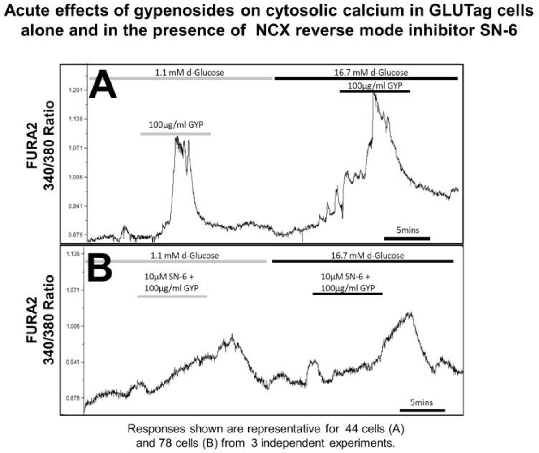| 113P London, UK Pharmacology 2017 |
Effects of Gypenosides on glucagon-like peptide-1 (GLP-1) release from intestinal L-cells
Introduction: Gypenosides are glycosides extracted from the plant Gynostemma Pentaphyllum. Gypenosides are known for their glucose lowering effects both in vitro and in vivo (1), although their mechanism of action is unclear. GLP-1 is an incretin hormone produced in gut L-cells which enhances β-cell insulin release. Methods to enhance endogenous GLP-1 may improve glucose control in diabetes. This study aimed to elucidate gypenosides effects on the function of GLP-1 secreting intestinal L-cells using the well characterised GLUTag L-cell model (2).
Methods: GLUTag cells were maintained in DMEM (1g/L glucose) supplemented with 10% FBS, 50U/ml penicillin/streptomycin and 2mM L-Glutamine. Gypenoside extract was prepared by dissolving gypenosides in absolute ethanol. Metabolic activity was determined by MTT assay following treatment of GLUTag cells with gypenosides (0.39 to 200μg/ml) for 24 h. RNA was extracted from GLUTag cells following 24h culture with 50 μg/ml gypenosides and L-cell specific (glucagon (GCG), proprotein convertase1/3 (PC1/3), sodium-glucose transporter (SGLT-1), glucokinase (GCK) and NFκB1) gene expression changes quantified by qPCR. Gypenoside effects on intracellular calcium were determined in FURA-2 loaded GLUTag cells at both low and high glucose concentrations, both in the absence and presence of specific ion channel blockers. GLP-1 release from GLUTag cell monolayers was assessed during 1h treatment with gypenosides and quantified using a total GLP-1 ELISA Kit (Millipore).
Results: Cell metabolic activity increased following 24h culture in media containing 50 & 100μg/ml gypenosides (n=8; p<0.01). Gypenoside culture down-regulated GCG, PC1/3 and NFκB1 gene expression (P<0.01). Gypenosides (50 & 100 μg/ml) stimulated acute GLP-1 secretion (n=4) from GLUTag cells at both low (1.1 mM) (2.7-7.5 fold P<0.01) and high (16.7 mM) glucose (3.6-13.5 fold P<0.01) concentrations. An increase in intracellular calcium was observed after gypenoside treatment at both low and high glucose concentrations, which was unaffected by L-type (nifedipine and verapamil) and T-type (mibefradil) calcium channel blockers. However, sodium-calcium exchanger (NCX) reverse mode inhibitor, SN-6, blocked gypenoside-induced increase in intracellular calcium.

Conclusion: The increased cell viability and altered gene expression by gypenoside suggests that gypenosides may modulate L-cell function. Interestingly, acute gypenosides exposure increases intracellular calcium and stimulates GLP-1 secretion from GLUTag cells possibly via activation of NCX reverse mode. Further studies are required to determine the interaction between gypenoside and NCX in gut endocrine cells.
References:
1. Lokman EF et al. (2015) Evid Based Complement Alternat Med:120572.
2. Drucker DJ et al. (1994) Mol Endocrinol 8:1646-55.

